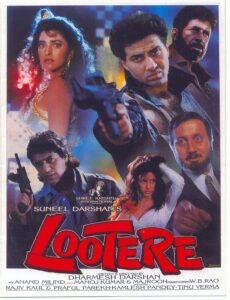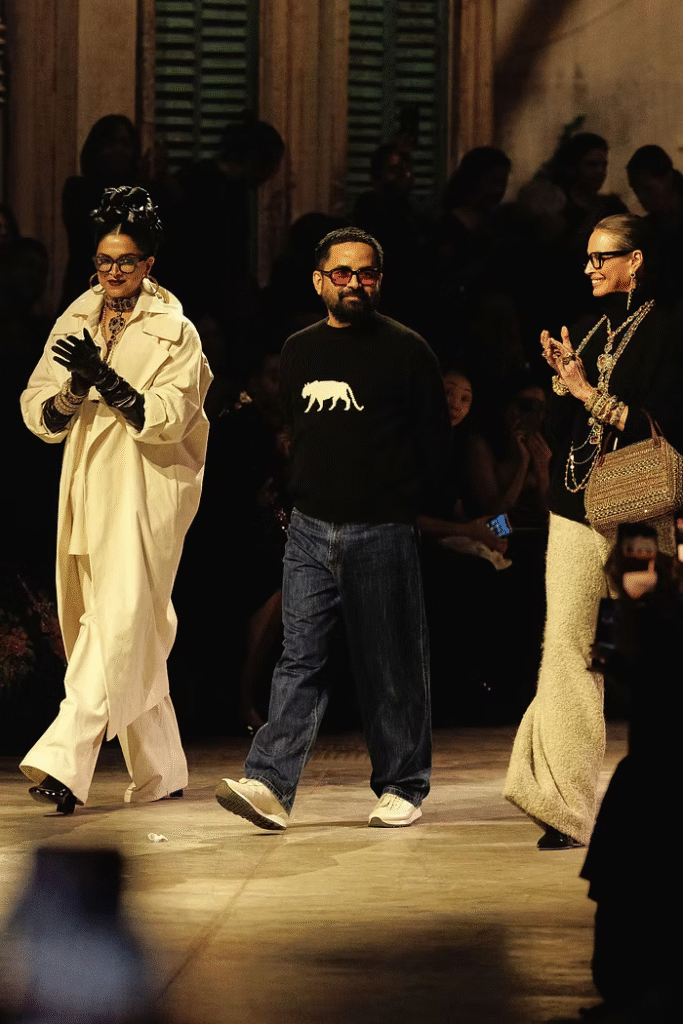
The 25th-anniversary celebration of Sabyasachi created a charm worth talking about in length. Regardless of the aspects that didn’t land from the lens of critique, it must be said that they did create some magic. The celebration beautifully narrated the poetry of humble beginnings transforming into a globally celebrated legacy. Sabyasachi Mukherjee, a graduate of the prestigious fashion institution of NIFT with honours, rejected all the conventional norms the world of fashion had to offer. From turning away every job offer that came his way to charting his course, he focused on creating a space for his art more than himself. With just a 20,000 INR loan from family members and a workforce of only three, the man went on to create a legacy that India is so proud to call its own.
To truly understand why this celebration felt like poetry, one must look at the song that elevated the atmosphere: a rendition of ‘Jokhon Porbe Na Mor Payer Chihno’, written and composed by Rabindranath Tagore in 1916. This translates to, “When my footprints will not be seen anymore.” A recent comment by Sabyasachi Mukherjee, “Sabyasachi no longer belongs to me; it is an aspiration that belongs to India,” captures the essence of what this celebration represented.
Reflecting on how the event brought the aesthetic and experience of a mini Calcutta to the glamorous giant it has become, the presentation evoked a profound feeling—one that says life truly comes back in circles.
For the charm to come together as magic, it would be nearly impossible to not deep-dive into the decor of the celebration. While it was a mini-Calcutta dreamland, the contrasting elements shown were truly out of this world. Beginning with the humble charm of Calcutta, two dilapidated houses with quintessential North Kolkata features—connected by a clothesline—stood as a tribute to the simplicity and beauty of everyday life. One can’t help but think about how the art behind garments brings together various elements of life. Sabyasachi gave an evident homage to the golden lessons passed down by his grandmothers, and it was these thoughtful details that exuded the purity of bonds cherished during his upbringing, shaping the elegance he carries today as a designer.
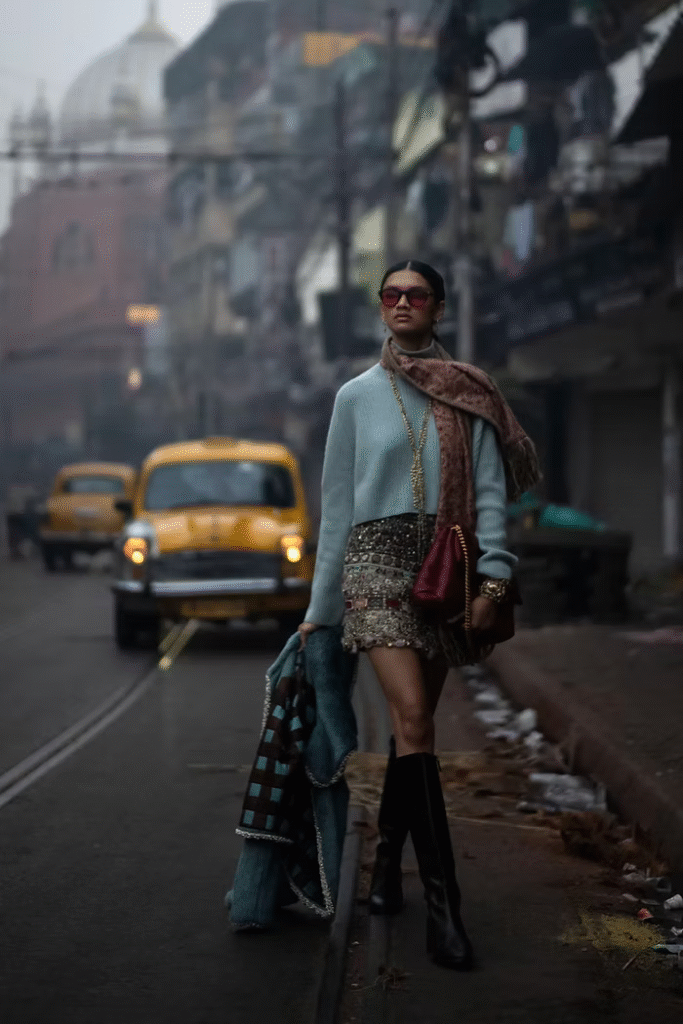
The narrative continued with colonial tales seamlessly woven into the decor, symbolized by a colossal water fountain, seemingly plucked right out of the Victoria Memorial, sitting grandly at the centre. The aesthetics weren’t merely curated to impress with elegance or class; they were designed to represent the culture and experiences witnessed by Sabyasachi himself and what he carries forward through his legacy. The Khoikhoi windows painted in green—a colour chosen by the British East India Company for its affordability—were prominently featured and stood out in the verandas, reminding one of the old capital city’s colonial past. Another charming, eye-to-detail feature was the houses skirting the runway, detailed right down to the switchboards with iconic flickable switches, a nostalgic nod to times past—elements still found in old cafes that hold timeless charm.
The Bengali culture was palpable in the air, not only through the visuals but also through the choice of music. As the event proceeded, the energy shifted seamlessly. Asha Bhosle and Lata Mangeshkar’s Bengali hits from the 60s played alongside Leonard Cohen and Usha Uthup numbers, creating a perfect harmony of nostalgia and vibrance that kept the audience enthralled.
And, well, it was Sabyasachi—so it wasn’t just what was on the runway that dazzled. The guest list itself was glimmering with its own light. One of the standout appearances of the evening came from Maharani Radhika Raje Gaekwad of Baroda, who graced the event with her regal presence. She stunned in a Paithani sari, a traditional heirloom piece steeped in centuries of history, paired, of course, with a statement necklace and earrings that only elevated her royal elegance.
The event successfully and glamorously brought together an exclusive gathering of over 680 guests from across the globe. As famed French fashion editor and stylist Carlyne Cerf de Dudzeele remarked, “This is total Indian panache and opulence,” perfectly encapsulating the evening’s grand spirit.
Can an Indian celebration truly be complete without the sparkle of Bollywood? The event’s glamorous guest list featured Bollywood stars like Ananya Panday, Aditi Rao Hydari, Siddharth, Shabana Azmi, Sobhita Dhulipala, Bipasha Basu, and Alia Bhatt, along with members of India’s renowned Ambani family. Every guest followed the invitation’s directive to dress in “strictly black,” infusing the evening with drama and elegance.
It was, without a doubt, a starry starry night!
Now let’s walk the talk with the tea from the runway. Let’s be super honest here—As much as we love Sabyasachi and take immense pride in the fact that it represents India, the show received a mixed response regarding the successes and misses on the runway. Nonetheless, it would be a debacle not to mention that Sabyasachi’s elevation to the world stage has only enriched the celebration of India’s rich ethos.
His collection at the Met Gala 2024 showcased a balanced blend of traditional Indian textiles with modern tapestries. In collaboration with Bergdorf Goodman, he presented handwoven sarees, lehengas, and high jewellery to New York’s luxury department stores. In the same year, the Heritage Bridal Edit showcased the resplendence of Indian weddings with regal tones, vintage textiles, and refined zari embroidery. Sabyasachi also propagated the accessibility of Indian artistry through his associations with global brands like H&M, Pottery Barn, Christian Louboutin, Starbucks, and Asian Paints. With combinations of Mughal motifs, Bengal’s royal legacy, and European techniques, the Sabyasachi Jewelry X Printemps Doha collection produced impressive pieces such as the Moulin Rouge necklace. His journey of cultural preservation also includes his work at the Sabyasachi Art Foundation, where he restores ancient Indian art forms such as Kalighat paintings, focusing on supporting artisans by promoting their artworks.

These landmark acts demonstrate his vision, which transcends the commodification of clothing and moves toward creating a cultural phenomenon. This sets our expectations to the highest possible level. The collection itself was akin to a Pinterest mood board. The interplay of maximalism and minimalism played a defining role in the show’s essence. Sabyasachi staples—handwoven fabrics, detailed embroidery, and plush jewellery—took centre stage. Inspirations from Mughal royalty, Bengal’s craft, and art deco were evident in the jewellery, with each piece serving as an ode to Bengal’s culture of tradition and modernity.
Tradition and modernity truly embody the essence of Sabyasachi’s style. The fashion collection featured oversized embroidered jackets over printed shirts, velvet pants, baggy trousers with cropped jackets, and oversized T-shirts. Accessories included bold jewellery and geek-chic glasses, while sunglasses, sweatshirts, long coats, and short skirts introduced a touch of Western modernity to traditional Indian elements. The models were lavishly adorned with jewels, while the clothing seemed purposefully simple—serving as a canvas enlivened by the artistry of the jewellery.
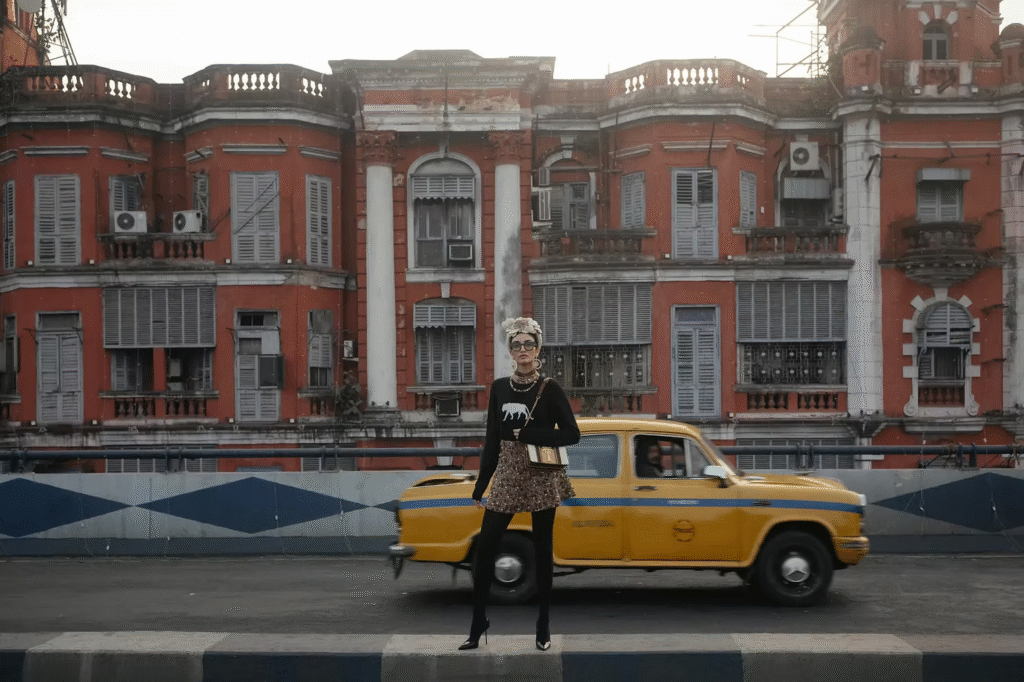
However, the evening stirred mixed reactions. While many admired the grandeur and the presentation of Indian culture on such a grand scale, others expressed concerns about the commodification of the Calcutta aesthetic in an attempt to impress international audiences. This criticism raised questions about the brand’s identity—whether Sabyasachi can maintain its sacred cultural status while catering to international standards. For some, the creation of Western prints or silhouettes seemed like a dilution of the brand’s ethos. Questions lingered: how will Sabyasachi stand out as an Indian brand creating Western attire in a market already saturated with global designers? Admirers, however, placed their faith in the brand’s unparalleled craftsmanship, which offers something the market has yet to see.
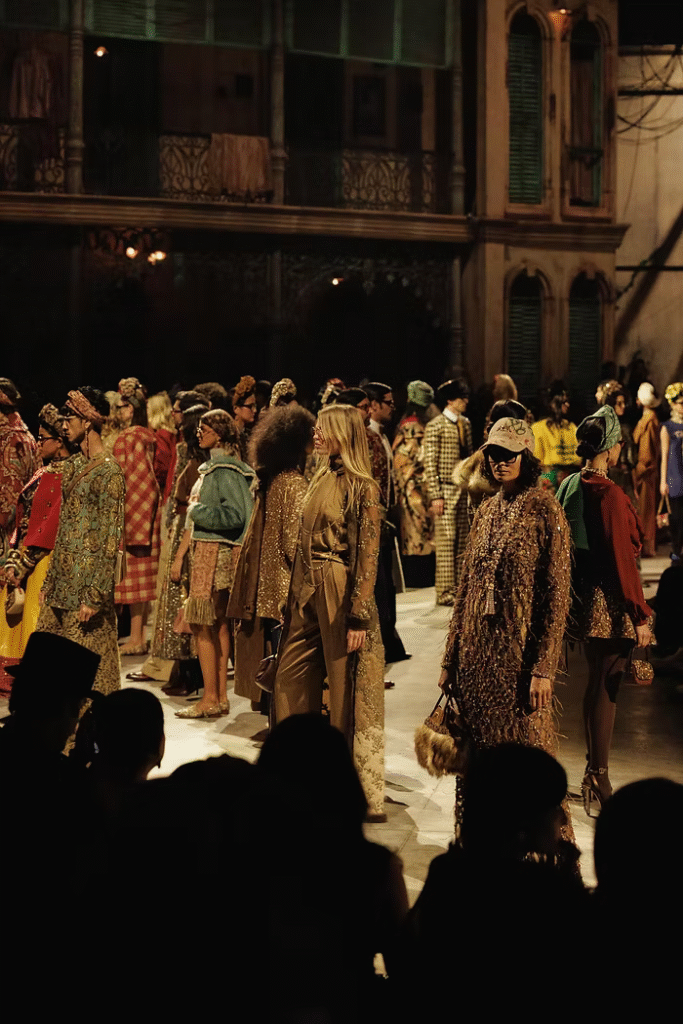
That said, not everything landed. The showstopper look worn by Deepika Padukone, described as a form of ‘Rekhafication,’ was intended as a modern tribute to the legendary actress Rekha. While the intention was appreciated, the execution felt lacking. The simplicity of the look, paired with heavy jewellery, seemed incomplete and fell short of the grandeur expected from Sabyasachi. Significant disapproval was also directed at the trousers, which many regarded as disorganized and inconsistent with the event’s otherwise cohesive tone. They appeared crude and out of sync with the refined legacy that Sabyasachi has carefully built over the years.
Well, whatever might be the case with the tea from the runway, one thing Sabyasachi never fails at is getting the conversation started—whether it’s an aww moment or a nah. And when it comes from a label like his, it undoubtedly hits the spot, ensuring the conversation lingers on. We’re still trying to process how we feel about the cheeky redirection of this elegant label, with its T-shirts embroidered with sequin-encrusted phrases like “Where Has the Love Gone” and “Please Stay.”
The runway embodies the perfect blend of contrasts, reminiscent of an enemies-to-lovers narrative, and we can only anticipate that Sabyasachi’s expansive vision will meet the high expectations set for this renowned label.




